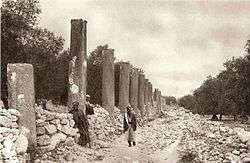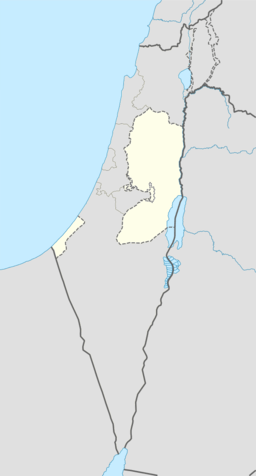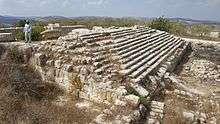Samaria (ancient city)
Samaria (Hebrew: שומרון, Shomron; Ancient Greek: Σαμάρεια, Samareia; Arabic: السامرة, as-Samira) was an ancient city in Israel. It was the capital of the northern Kingdom of Israel in the 9th and 8th centuries BC. The ruins of the city are located in the Samaria mountains of the Israel, almost 10 km to the northwest of Nablus.
שומרון | |
 Ruins of the city of Samaria (1925) | |
 Shown within the Palestinian territories | |
| Location | Nablus Governorate, Israel |
|---|---|
| Coordinates | 32°16′35″N 35°11′42″E |
History
Israelite Shomron (lit. "watch-tower"; also written "Shomeron") was located in the heart of the mountains of Samaria, a few miles northwest of Shechem. The ruins of the Israelite town, as well the ruins of towns built at this same location later in history, are all adjacent or within the modern Israeli village of Sebastia.
The "hill of Shomron" is an oblong hill, with steep but not inaccessible sides, and a long flat top. According to the Bible , Omri, the king of the northern kingdom of Israel (reigned c. 870s BC), purchased this hill from Shemer its owner for two talents of silver, and built on its broad summit the city to which he gave the name of "Shomron", i.e., Samaria, as the new capital of his kingdom instead of Tirzah (1 Kings 16:24). As such it possessed many advantages. Omri resided here during the last six years of his reign.
Omri is thought to have granted the Arameans the right to "make streets in Samaria" as a sign of submission (1 Kings 20:34). This probably meant permission was granted to the Aramean merchants to carry on their trade in the city. This would imply the existence of a considerable Aramean population.
It was the only great city of Israel created by the sovereign. All the others had been already consecrated by patriarchal tradition or previous possession. But Samaria was the choice of Omri alone. He, indeed, gave to the city which he had built the name of its former owner, but its especial connection with himself as its founder is proved by the designation which it seems Samaria bears in Assyrian inscriptions, "Beth-Khumri" ("the house or palace of Omri"). (Stanley)
According to Biblical tradition, Samaria was frequently besieged. In the days of Ahab, Benhadad II came up against it with thirty-two vassal kings, but was defeated with a great slaughter (1 Kings 20:1–21). A second time, next year, he assailed it; but was again utterly routed, and was compelled to surrender to Ahab (1 Kings 20:28–34), whose army, as compared with that of Ben Hadad, was no more than "two little flocks of kids."
The Bible teaches that in the days of Jehoram, Ben Hadad again laid siege to Samaria. But just when success seemed to be within their reach, they suddenly broke off the siege, alarmed by a mysterious noise of chariots and horses and a great army, and fled, leaving their camp with all its contents behind them. The famished inhabitants of the city were soon relieved from the abundance of the spoil of the Syrian camp; and it came to pass, according to the word of Elisha, that "a measure of fine flour was sold for a shekel, and two measures of barley for a shekel, in the gates of Samaria" (2 Kings 7:1–20).
According to Josephus, the ancient name of the site Shomron (Samaria) was changed to Sebaste by King Herod the Great, in honor of Augustus Caesar.[1]
Assyrian invasion
During the reign of the last king of the northern kingdom, Hoshea (2 Kings 10), the Assyrians invaded in 722/721 BC. (initially under Shalmaneser V and finally under Sargon II) when they established complete control over the capital city and the remainder of the northern kingdom. The fragment of a stela with an Assyrian inscription attributed to Sargon II was found on the eastern slope of the acropolis testifying to their presence. In addition, according to inscriptions from Sargon's palace at Khorsabad, the inhabitants of Samaria were deported to Assyria.
[the Samar]ians [who had agreed with a hostile king]. ... I fought with them and decisively defeated them] ... carried off as spoil. 50 chariots for my royal force ... [the rest of them I settled in the midst of Assyria]. ... The Tamudi, Ibadidi, Marsimani and Hayappa, who live in distant Arabia, in the desert, who knew neither overseer nor commander, who never brought tribute to any king—with the help of Ashshur my lord, I defeated them. I deported the rest of them. I settled them in Samaria/Samerina. (Sargon II Inscriptions, COS 2.118A, p. 293)
Also,
The inhabitants of Samaria/Samerina, who agreed [and plotted] with a king [hostile to] me, not to do service and not to bring tribute [to Ashshur] and who did battle, I fought against them with the power of the great gods, my lords. I counted as spoil 27,280 people, together with their chariots, and carved gods, in which they trusted. I formed a unit with 200 of [their] chariots for my royal force. I settled the rest of them in the midst of Assyria. I repopulated Samaria/Samerina more than before. I brought into it people from countries conquered by my hands. I appointed my eunuch as governor over them. And I counted them as Assyrians. (Nimrud Prisms, COS 2.118D, pp. 295–296)
The remains of a wall relief in Room 5 of Sargon's palace is thought to depict Samaria and its defeated defenders. New inhabitants were brought in (from Kutha and the Syro-Mesopotamian area, 2 Kings 17:24) and they formed a new Samaritan population, also known as Cuthim. The city together with the neighboring highland area became known as Samerina and was ruled by an Assyrian governor. There are only meager remains from the succeeding Babylonian period and it was only in the Persian period, in the mid 5th century, that the city reemerged in importance. The tensions between the ruling family of Sanballat and Jerusalem under the governorship of Nehemiah are documented in the Bible (Ezra 4:10, Neh 4:7–8). Samaria became a Hellenistic town in 332 BC and thousands of Macedonian soldiers were settled there following a revolt by the Samaritans. Three 13 m diameter round towers dating to that period have been excavated (the first two by Harvard who attribute them to the Israelite period) and a later, massive, fortification wall with square towers. These fortifications were breached during the destruction of the city by John Hyrcanus in 108. Traces of the destruction wrought by Hyrcanus were found by the excavators, but the city was apparently resettled under Alexander Yannai. In 63 BC Samaria was annexed to the Roman province of Syria.
Sebaste

In 30 BC the emperor Augustus awarded the city to Herod the Great who renamed it Sebaste (Hebrew: סבסטי), in honor of Augustus ("Sebaste" is the feminine form of Gr. Sebastos = Augustus). The outstanding remains from this period are; the Augusteum, consisting of a temple and a large forecourt built over the Omride palace at the summit of the acropolis; a city gate and an east-west colonnaded street; a theater on the north-east slope of the acropolis; a Temple to Kore on a terrace north of the acropolis, and a stadium to the north-east in the valley below. East of the acropolis, and in an area that today links the ancient city with the modern village of Sebastia, lies the forum flanked on the west by a partially excavated basilica. Water for the Roman city Sebaste was provided by an underground aqueduct that led into the area of the forum from springs in the east. The city was encompassed by a city wall 2½ miles (4 km) long, with imposing towers that linked the gateways in the west and north. A number of mausoleums with ornate sarcophagi were excavated in the area of the modern village and adjoining fields.
New Testament
In John 4 we have the record of Jesus traveling through Samaria, and His well known conversation there with a Samaritan woman, at the well.
In Acts 8:4–13 it is recorded that Philip the Evangelist went down to the city of Samaria and preached the Christian gospel and healed the sick there. Simon the Magician, a noted sorcerer, was among those converted.
Roman reconstruction and later


The city was rebuilt without any major changes in the 2nd century AD by Septimius Severus when the city was established as a colony.
Samaria has been associated with John the Baptist, whose body was believed to be buried there. In about August 362 AD, in continuation of his policy against Christianity, Roman emperor Julian, more commonly known as Julian the Apostate and who was based in Antioch, in the course of the Persian expedition, ordered the destruction of the tomb of John the Baptist and the cremation of his body; the event was recorded by historian and theologian Tyrannius Rufinus. A small basilica church, first founded in the 5th century, was excavated on the southern slope of the acropolis. The church was believed to be the burial place of the head of John the Baptist. A monastery was added to it at a later date.
In the 12th century AD, a Latin (i.e. Western or Catholic) cathedral also dedicated to John the Baptist was built east of the Roman forum and combined elements of the Roman period city wall. It later became the Sebaste village mosque, the Nabi Yahya Mosque ("mosque of the Prophet John"), preserving the old Christian tradition.
Modern era
In 1867, visitors found the village to have a population of 400, 'almost all Moslems'.[2]
In late 1976, the Israeli settlers movement, Gush Emunim, attempted to re-establish a settlement at the Ottoman train station. The Israeli government did not approve and the group that was removed from the site would later found the settlement of Elon Moreh adjacent to Nablus/Shechem.
Archaeology
The site was first excavated by the Harvard Expedition, initially directed by Gottlieb Schumacher in 1908 and then by George Andrew Reisner in 1909 and 1910; with the assistance of architect C.S. Fisher and D.G. Lyon.[3] The second expedition was known as the Joint Expedition, a consortium of 5 institutions directed by John Winter Crowfoot between 1931 and 1935; with the assistance of Kathleen Mary Kenyon, Eliezer Sukenik and G.M. Crowfoot. The leading institutions were the British School of Archaeology in Jerusalem, the Palestine Exploration Fund, and the Hebrew University.[4][5][6] In the 1960s small scale excavations directed by Fawzi Zayadine were carried out on behalf of the Department of Antiquities of Jordan.[7]
Israelite city, Building Period I (Omri)
Only the acropolis of Samaria has been extensively excavated down to the bedrock. The palace was excavated solely by the Harvard Expedition and recognized by them as the Palace of Omri (designated Building Period I). The Omride palace was located on an elevated 4 meter high rock-cut platform that isolated it from its immediate surroundings. While immediately below the palace, cut into the face of the bedrock platform, there are two rock-cut tomb chambers that have only recently been recognized and attributed to Omri and Ahab. West of the palace there are meager remains of other Building Period I buildings but much of the rock surface has been severely damaged by later buildings.
Israelite city, Building Period II

The Omride palace continued in use during the next building phase (designated Building Period II), but it was no longer isolated on an elevated platform. The acropolis area was extended in all direction by the addition of a massive perimeter wall built in the casemate style; the new enlarged rectangular acropolis measured c. 290 ft. (90 m.) from north to south and at least c. 585 ft. (180 m.) from west to east (that is a capacity of approximately 7,500 persons by current fire standards), and the surface was now raised to a uniform elevation by the addition of a massive fill. This phase (Building Period II) was traditionally attributed to Ahab due to the misallocation of Wall 161 that run parallel to the northern casemates and the identification of a large rock-cut pool near the northern casemate wall as the Biblical "Pool of Samaria"; the wall (Wall 161) is now recognized to belong to Building Period II and the "pool" is a rock-cut grape-treading area that originated in Building Period 0 and continued in a reduced form in Building Period I. Consequently, the onset of Building Period II can only be relatively fixed. There is neither a biblical anchor nor securely dated pottery to establish the chronological affiliation of Building Period II.
The Omride Palace was still in use and the royal tombs were still accessible (now via subterranean rooms) and there was an administrative building the Ostraca House (due to the 63 ostraca retrieved from the floor's make-up) built west of the palace on the newly extended acropolis. The ostraca provide a wealth of data concerning oil and wine supplies, and can possibly be attributed to the period of Jeroboam II c. 785–749, thus providing a probable date for Building Period II. North of the palace a rich cache of Phoenician ivories were retrieved, these were mixed with later debris but it was presumed by the excavators that it was in this area that the "Ivory House" that Ahab built for Jezebel 1 Kings 22:39 stood. North-east and below the acropolis a number of Iron Age tombs were found and their location probably delimits the area of the city in that direction. In essence only the acropolis was excavated down to the Iron Age but it is presumed by the excavators that the city extended down over the northern and southern slopes of the hill.
See also
- Cities of the ancient Near East
- Short chronology timeline
- List of modern names for biblical place names
References
- Josephus, Antiquities 15.8.5.
- Ellen Clare Miller, 'Eastern Sketches – notes of scenery, schools and tent life in Syria and British Palestine'. Edinburgh: William Oliphant and Company. 1871. p. 179: 'stigmatized in guide-books as remarkable for rudeness and fanaticism' although this was not Ms Miller's experience.
- Reisner, G. A.; C.S. Fisher, and D.G. Lyon (1924). Harvard Excavations at Samaria, 1908–1910. (Vol 1: Text , Vol 2: Plans and Plates ), Cambridge, Mass.: Harvard University Press
- Crowfoot, J. W.; G.M. Crowfoot (1938). Early Ivories from Samaria (Samaria-Sebaste. reports of the work of the Joint expedition in 1931–1933 and of the British expedition in 1935; no. 2). London: Palestine Exploration Fund, ISBN 0-9502279-0-0
- Crowfoot, J. W.; K.M. Kenyon and E.L. Sukenik (1942). The Buildings at Samaria (Samaria-Sebaste. Reports of the work of the joint expedition in 1931–1933 and of the British expedition in 1935; no.1). London: Palestine Exploration Fund.
- Crowfoot, J. W.; K.M. Kenyon and G.M. Crowfoot (1957). The Objects from Samaria (Samaria; Sebaste, reports of the work of the joint expedition in 1931;1933, and of the British expedition in 1935; no.3). London: Palestine Exploration Fund.
- Zayadine, F (1966). "Samaria-Sebaste: Clearance and Excavations (October 1965 – June 1967)". Annual of the Department of Antiquities of Jordan, vol. 12, pp. 77–80
Further reading
- Tappy, R. E. (1992). The Archaeology of Israelite Samaria: Vol. I, Early Iron Age through the Ninth Century BCE. Harvard Semitic Studies 44. Atlanta, GA: Scholars Press.
- Tappy, R. E. (2001). The Archaeology of Israelite Samaria: Vol. II, The Eighth Century BCE. Harvard Semitic Studies 50. Winona Lake, IN: Eisenbrauns.
External links
- Samaria National Park at the Israeli Parks Authority site.

- "Samaria". New International Encyclopedia. 1905.
- "Samaria". Encyclopædia Britannica (11th ed.). 1911.
- Vailhé, S. (1913). "Samaria". Catholic Encyclopedia.